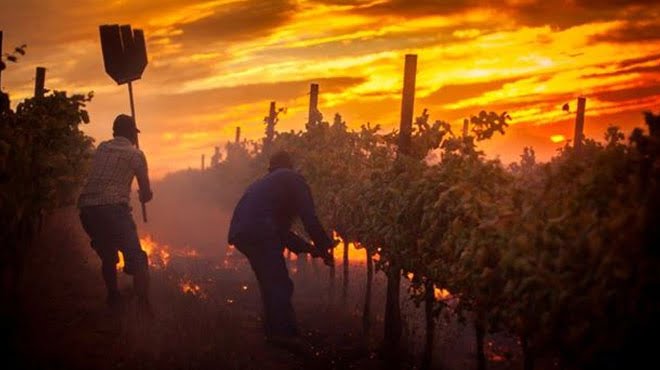The recent spate of fires in the winelands of the Western Cape has again brought the issue of the wine producer’s risk to the fore, with a number of wine farms being adversely affected. Shehnaz Somers, head of commercial underwriting at Santam said the company is still assessing the damage and loss as a result of fires spreading to well-known vineyards and guest farms in the winelands and surrounding areas over the past month.
“Our claims team is assessing about 50 claims related to the recent fires, most of which are related to buildings and vineyards but it is still too early to report on the exact extent of the damage. We know that last year, runaway fires destroyed vineyards in Stellenbosch‚ Overberg‚ Simonsberg and Kogelberg early in 2016 resulting in losses estimated at around R240 000 per hectare. This included the loss of income to the farmers and the additional labour costs required to re-establish the vineyards,” says Somers.
Somers says it could take between five and seven years for an average wine vineyard to become productive again after a loss or significant damage. The loss of a vineyard can have a major impact and knock-on effect on the financial viability of the farm operation as a whole. “The destruction of vineyards by fire, crime or weather-related events also has a significant impact on the overall production volumes which in turn places international exports and revenues – and ultimately the livelihoods of those communities engaged in the wine producing sector at risk.”
South Africa has a rich wine heritage and is ranked among the top ten wine producing countries in the world but for the individual wine farmer guarding against the various risks he or she may face, is absolutely instrumental to the lifeblood of the business as well as the South African economy.
Currently, there are about 98 597 hectares of vines producing wine grapes under cultivation in South Africa – an area covering some 800 kilometres in length. Thanks to strong exports to large parts of Europe and America especially, the South African wine industry is a significant foreign exchange earner for the local economy. The South African Wine Industry Information and Systems (SAWIS) confirms that local revenues from the wine industry contributes more than R36 billion to the national GDP and provides employment to more than 300 000 people.
Most local wine farmers have insurance protection against weather-related incidents. Industry reports show that a number of them are still grappling with the consequences of a protracted drought in early 2016. Says Somers: “Since the majority of local wine farms are not limited to one single varietal, a number of producers have more than one estate which is often spread over different districts or regions, in order to get better diversity in the taste of their grapes. Resultantly, the wine producer’s risk is also spread geographically, which can serve to mitigate the risk somewhat.”
The risks to the wine producer are also present in the supply and distribution chains to which he or she is inextricably linked. Santam is the largest insurer in the local agricultural sector and provides additional and specific cover to the vine industry. The company insures close to 200 of the 600 wine farms in the Western Cape alone providing cover against specific risks including liability, contamination and recall of products.
Somers explains that when it comes to insurance, the local wine industry presents some very particular risks. “Apart from the standard cover for theft, fire and severe weather related incidents, wine farming requires a type of specialist cover to provide financial security to the producer – from planting through to production, bottling and distribution. These risks include fire damage to plant materials, uprights and trellises as well as any loss of revenue or income that the farmer may suffer should his vineyard be destroyed by fire.”
Once the grapes have been harvested, risks originating from accidental damage or loss during the wine making process itself are covered through an accidental damage cover that offers protection should the wine become contaminated. Extended liability cover protects the farmer or wine producer against any additional legal liability or claims that may result from defective or contaminated products or in the event that it is recalled from shelves or export containers.
In 2016, Santam paid out 596 claims worth more than R9,4 million to the wine industry. These claims were specifically related to agricultural assets. In many cases, the claims were as a result of fire, accidental damage or liability. “The wine industry requires a highly specialised approach to insurance which is why we have a team of experts who are adept at their approach to this sector. We believe that safeguarding their revenues is pivotal to the long term sustainability of wine farming in South Africa and the economy as a whole,” concludes Somers.
